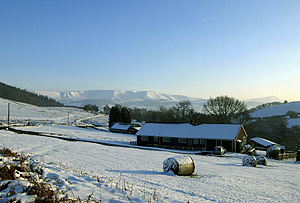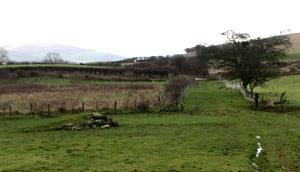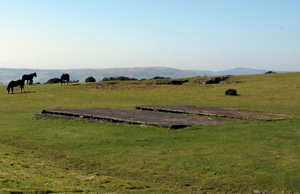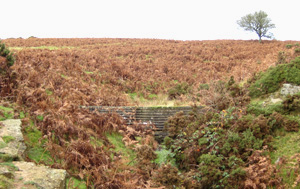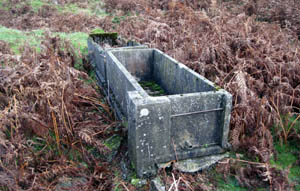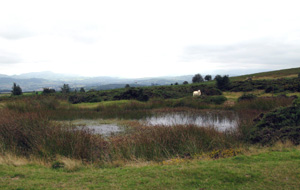| Introduction Some
temporary but important events occurred during World War Two when
the War Agricultural Executive Committees implemented farming changes
for a second time. The effect of the "War Ags" was to
increase the productive land in the UK by over 1.5 million acres
between 1939 and the early 1940's and this included large areas
of common land.
Cattle, sheep and pigs for meat along with milk, potatoes and cereals
were considered to be essential to the food supply and the 'Warags'
implemented stringent and controlling conditions on the farmers
and their activities for the duration of the war.
Some local commons were commissioned and utilised by the 'Warags'
and run by the farmers, with help from the Land Girls and some POW's
as outlined below.
Ffynnon Gynydd Common
- An article written and contributed by Fred Lloyd on June
21st 2016
I am old enough to recall the 'War Ags', as they
were called, taking over the common adjacent to where I lived, I
would have been about 4 or 5 years old at the time and despite my
age, I do have a pretty good memory of the happenings at that time.
Sixty acres of land were set aside to be farmed in order to produce
food – potatoes and corn. Machinery, the like of which we
had never seen before appeared and was used in reclaiming this land.
As the ploughing progressed very large stones came to light and
these had to be removed. Two or maybe three Caterpillar tractors
arrived and I can recall them being started up in the mornings,
this was achieved by a donkey engine ( nowadays this would be an
electric starter motor). The small donkey engine would be started
and through a gradual clutch engagement it would turn the main power
engine, I can clearly remember the roar as these engines burst into
life.
It was a big task to remove these very large stones and they can
still be seen at the top of the common but most of them were pulled
to the bottom just below the road to Coed-y-Glas, possibly to remain
there forever. A short distance away from these stones a store shed
was erected, some of the concrete base still remains.
When the land was prepared the first crop to be planted was potatoes,
for some reason I cannot remember the potatoes being set but I do
have a fairly clear picture of the potatoes being harvested. This
was done by a very labour intensive machine pulled by a tractor
and at the front of the machine was a blade resembling a mooter
which pushed most of the potatoes and lots of rubbish, stones etc,
to the surface. This was all picked up by conveyer roughly eight
feet long which was made of a mesh that vibrated and acted like
a riddle getting rid of lots of stones and rubbish as it travelled
to the rear of the machine. Of course lots of the larger stones
would not pass through the mesh so these had to be removed by hand,
this was achieved by having three Land Girls sat each side of the
conveyer, you could say this was a sorting process. The much needed
potatoes then went over the back end into a trailer and were taken
down to the new shed from where they were dispatched by lorries.
The next crop to be produced on this 60 acre piece of common land
was corn and the first Combine I had ever seen arrived. It was as
I recall self propelled with the driver sat high up with good view
of the corn being cut. It was a very similar machine to todays Combine
but much larger and more labour intensive. At the end of the war
the common was allowed to revert to its original state. Now sheep
graze it and many walkers, some with dogs use it daily , a very
different scene from when it was used to produce food to help the
survival of our country in the years of World War Two.
Fred Lloyd
June 21st 2016
The Begwyns
During the War a large part of the Begwyns in the
south west was commissioned for the grazing of cattle and the growing
of mainly potatoes. Some 300 acres were fenced off and ploughed,
initially for growing oats and afterwards for potatoes. These were
clamped and stored on the common to be used as and when required.
Two nissen style huts with concrete bases were built to house the
necessary equipment and a loading ramp constructed at GR 139 435
to service transport of the produce from the Begwyns. The huts were
also used as repair sheds and shelters for lunch breaks and foul
weather conditions. Land-girls were employed to work with the farmers,
and also a few POW's. They all helped in the construction, planting
and running of the scheme.
After the war and around 1949 the graziers held a meeting and after
a spirited discussion agreed that the land should revert to common
usage. Today there is little evidence left of any extensive crop
growing, but there are however some remaining legacies worthy of
note.
Approaching from the west the first of these
can be found at GR 139 435 and is the loading ramp mentioned above.
The second can be found at GR 143 435. These are
the two concrete bases; all that is left of the nissen style huts.
The third is the small dam and related water
troughs which were constructed for the benefit of the cattle and
can be found in the area of GR 149 436. The water was piped from
the dam to the troughs to provide a reliable and safe supply.
The fourth was a post-war event and is known locally
as 'The Bomb Hole' . During the war ammunition was safely stored
in a variety of depots ( A large one was created at Gwernyfed )
and these became redundant with the advent of peace. After a few
minor and trial explosions it was decided to dispense with the remaining
ammunition in one fell swoop and the Begwyns was the favoured and
chosen site. In due course the ammunition was sited at a safe distance
from the road at GR 178 443 and the demolition team at a even safer
distance in the ditch to the southwest. The bomb-blast was successful
but ruptured the bed-rock below, allowing a spring-line to create
a small lake which has remained largely full since that time.
In the aftermath there was significant structural damage to some
local farm buildings and this resulted in token monetary compensation
where necessary.
B Bowker
August 21st 2016
Sources
Mr Fred Lloyd
Mr Paul Greenow
Mr A A Nicholls of Croesfeilliog
Mr Aubrey Price of Llwynpenderi
Other local farmers
Photographs - B Bowker
|


